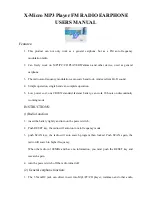
TK-380
11
AND/OR
Option Signaling match conditions can be selected with
AND/OR logic.
Alert/Transpond
AF Mute Open
AND
Triggers at match with QT/ Triggers at match with QT/
DQT/ID+DTMF(2tone);Both DQT/ID+DTMF(2tone);Both
OR
Triggers only for match with Triggers only for match with
DTMF (2tone) : Opt
QT/DQT/ID;Signaling
Even if set for OR, AF mute cannot be canceled just by a
match with DTMF.
In channels not set with QT/DQT, signaling is a match just
by receiving the carrier.
Auto Reset
When Option Signaling matches on a Group channel where
set to Yes, Option Signaling is canceled when it matches a
group channel set to Yes.
After Option Signaling is a match, Option Signaling can
automatically set to Reset after a specified time.
Stun/Kill
If the Stun code matches, a predetermined action will occur.
Whether option signalling is activated or not, when stun code
matches on any channel, the transceiver will become stun or kill.
While stun is active(“LOCK 2” appears), if the stun code +
“#” code is received, stun will disactive.
While kill is active(“ERROR” appears), the transceiver will
be disable all functions. The transceiver must be reprogrammed
by the FPU(KPG-60D) to operation again.
6. Alphanumeric Two-way Paging Function
(Digital Message System)
■
General
The Alphanumeric Two-way Paging Function (DMS) is a
Kenwood proprietary protocol. It enables a variety of paging
functions.
■
ID Construction
A radio unit ID is defined by a combination of 3-digit Fleet
and 4-digit ID numbers. Each radio unit must be assigned its
own Fleet and ID numbers.
■
Digital Message System[DMS]
●
Inter-fleet Call
Inter-Fleet Calls allow a radio of one Fleet number to call a
radio with a different Fleet number (radio users can manually
dial a Unit ID with a different Fleet number).
■
PTT ID
A pre-programmed unique ID can be sent at the beginning
of transmission and/or the end of transmission to identify which
radio unit is on air.
■
Selective Call (SELCALL)
This is a voice call to a particular individual or group of stations.
●
Example of call types;
[100][ALL ] : <Group Call>
All the units whose fleet number is “100” are called.
[100][1000] : <Individual Call>
The unit, whose the fleet number is “100” and ID number is
“1000”, is called.
[ALL][ALL ] : <Broadcast Call>
All the units are called.
[ALL][1000] : <Supervisor Call>
All ID “1000” are called regardless of their fleet number.
●
Unit ID Encode Block
Encode ID Block can be set to limit manual dial ID. The
radio unit will not accept an ID other than these IDs which
are entered from the keypad. If Inter-fleet Call is enabled,
block ID setting affects each fleet group.
■
Status Message
Using a 2-digit number, you can send and receive a Status
message which may be decided in your talk group. Each Status
may be displayed with 16 alphanumeric characters if
programmed in the radio. A maximum of 15 received messages
can be stored in the stack memory, and it can be reviewed
after reception. If the message memory becomes full, the oldest
one will be erased. The stack memory will be cleared by turning
radio power off.
●
Status 80~99 (Special)
Status numbers from 80 to 99 are reserved for special
purposes. Entering these statuses from the DTMF keypad
can be inhibited.
Please notice that the following status numbers are used
for special purposes;
80~89 : Reserved for future use.
90 : Remote kill on. Disable all transceiver functions.
91 : Remote stun on. The transceiver cannot operate.
92 : Turns stun off.
93 : Spare.
94 : Acknowledgement status sent when the radio unit is in
stun mode.
95~98 : Reserved for future use.
99 : Emergency Status.
Note : Remote stun works with DTMF stun function also.
●
Automatic Status Response
If you pre-select a status number and leave the radio in the
Status Mode, it can automatically respond with the selected
status number upon request from the base station. (The
request function is initiated by serial control on the base
station (Optional).)
OPERATING FEATURES
Содержание TK-380
Страница 33: ...TK 380 33 PARTS LIST ...












































